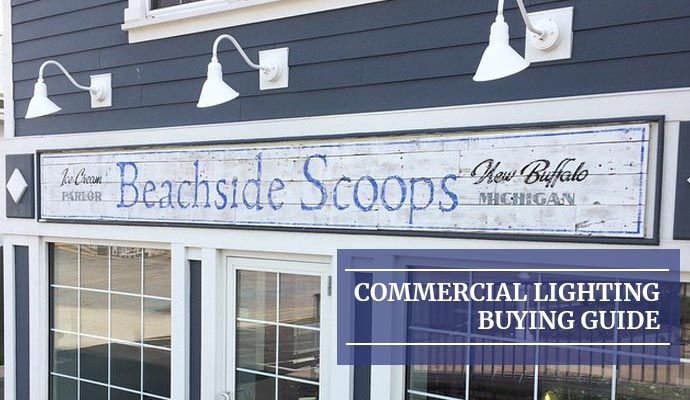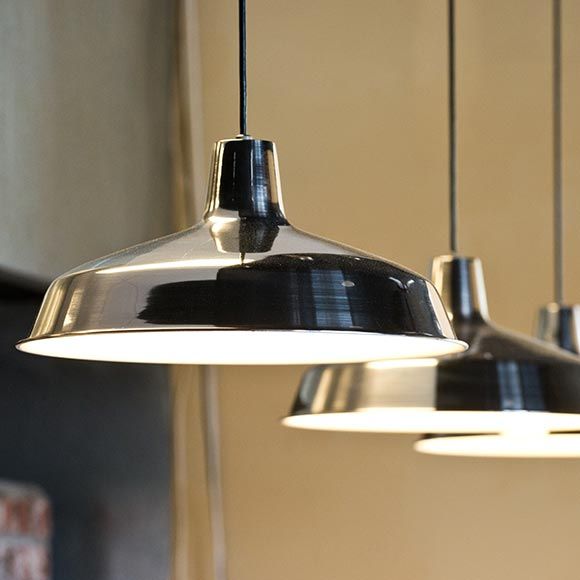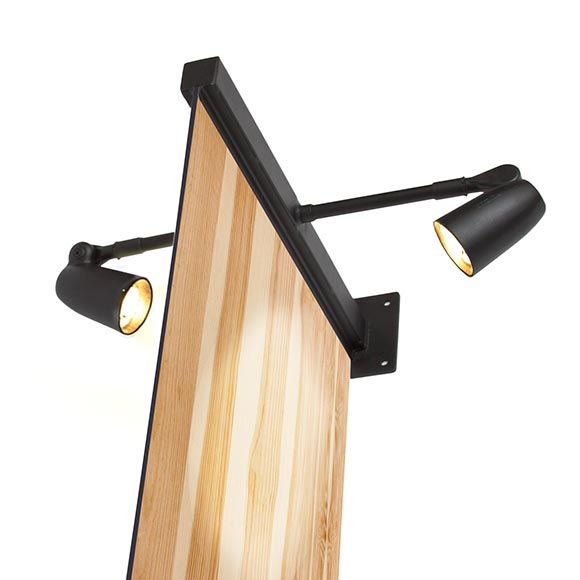
Effective Business & Sign Lighting
Effective commercial lighting draws attention to business signs and outdoor displays, maximizing their impact and improving the curb appeal of your storefront. But with so many lighting options to choose from and placement considerations to keep in mind, it can be a challenge to know which lighting option is right for you.
Our easy-to-use buying guide will help you choose the most effective outdoor lighting solution for your business exterior.
Before You Start: Things to Consider
Your Sign or Display Size
If you want to effectively illuminate your sign or display, you first need to consider its size. Once the size is determined, your lighting options can be narrowed to those that best accentuate the area you plan on illuminating. For example, a larger sign or display may require multiple lights spaced at the right intervals and distance from it in order to cover it completely and achieve the maximum effect.
Your Lighting Needs
Think about what you're trying to accomplish. Do you want to boldly highlight your sign or display with direct lighting or create a more low-profile effect with accent lighting? Do you have lots of outdoor space or is the space where you want to install lights limited? Are you looking for lights with a warmer, yellow glow or a bold, bright white beam? Knowing the answers to these questions will be of great help when selecting lamps, shades, mounting styles, and fixture color finishes.
How to Use This Guide
This step-by-step guide will help you choose the fixtures that are right for your specific business, and help you determine how to place them for the maximum effect. Read through the guide from beginning to end, or jump directly to the section that best suits your needs and answers your questions. And, as always, let us know if you have questions—we're here to help!
There are many decisions to make when choosing commercial lighting for outdoor signage. Considerations include: the light source (color/temperature, bulb style, etc.), type of shade, mounting system, color of the fixture, and any available accessories. These decisions will revolve heavily around the specific type of display you are illuminating. Take your time when considering options and don't be afraid to call us with any questions. When illuminating walls for company logos, branding, or monikers, it is important to find something eye-catching and durable.
Overall, there are typically four major considerations for choosing exterior wall and sign lighting. They include choosing the:
Light Source
Shade
Mounting Type
Color/Finish/Metal
Accessories
Step 1: Choosing a Light Source (Lamp)
When trying to draw attention to business signs and displays, the first decision lies in selecting the type of light source to be used. Standard lamp options include:
Incandescent
Compact Fluorescent
HIDs (such as Metal Halide and High Pressure Sodium
LED
There are unique advantages and disadvantages to each of these lamp types, so whichever is selected can greatly impact the power of your display. Here at the Sign Bracket Store, we can integrate nearly any lamping type into the lighting fixture of your choosing. Be sure to research the pros and cons of each lamp to determine which best suits your purpose.
Incandescent Lamps and Sockets
Incandescent (INC) lamps and sockets are typically less expensive than other lighting options listed above, and they provide greater illumination. However, these lamps are not as energy efficient and may not be the best option for outdoor lighting. Incandescent light bulbs often rank between 98 and 100 on the Color Rendering Index (CRI), a rating index that describes a light source’s ability to render all frequencies within the color spectrum, determining its ability to display an object's color naturally, or realistically.
LED Lamps
Light-Emitting Diode (LED) lights offers several advantages. First, they have a CRI rank of 92, making them some of the most realistic-looking lights when compared to natural light. But perhaps the greatest advantage of LED lights is their service life: they can provide years of use without worrying about replacing the bulbs. Plus they're energy efficient, which is great if you plan to continually leave your light on night after night. The only disadvantage to LED bullet lights is that they are not as bright as INC, CFL, MH, and HPS lamps, so exterior use isn't always ideal.
Compact Fluorescent Lamps
Compact fluorescent lamps (CFL) are an energy efficient solution, especially when compared to incandescent lamps. And by using less energy, you can save money on the costs of illuminating your outdoor signage. These lamps are generally used for floodlights that are placed away from the building. Fluorescent lights tend to rank between 50 and 90 on the CRI.
Metal Halide and High Pressure Sodium Lamps
High-intensity discharge (HID) lamps are similar to fluorescent lamps in that they offer a wide arc of illumination, which is beneficial for lighting a large display or illuminating from a further setback point. They tend to offer a greater illumination than fluorescent lights and are often available in both metal halide (MH) and high-pressure sodium (HPS) fixtures. HID lamps have a rank of 70 on the CRI. MH lamps project a brighter, whiter light while HPS lamps have a warm, almost yellow glow.
Step 2: Choosing a Shade
When selecting a shade, it is important to first consider how you will be using your lighting. A longer shade will allow you to focus your light on a smaller area while a shorter shade will offer a greater angle of lighting. A deep shade with a limited angle of light can be beneficial for direct lighting, such as when pointing your light at a specific spot on your display or pointing to a sign with your light. Conversely, a shallow shade can offer a wider angle of light, which can be beneficial for illuminating a large display or sign; an example of this is using floodlights to illuminate a wall. With gooseneck or bullet lights, you can also select from custom shade options to create a specific lighting style that works for you.
Step 3: Choosing a Mounting Type
When selecting a mounting system, you will need to consider the style of lighting that you wish to use. Such styles include bullet lights, floodlights, and gooseneck lighting. The mounting system that you choose will also impact your options for illuminating your walls or signage. For example, floodlights are generally spaced away from the building on sidewalks and pedestals, while lights attached to sign brackets will illuminate from above. Our sign lights and gooseneck lights have a myriad of solution-based mounting arm sizes and shapes, from the traditional shepherd's hook style to heavy duty parapet lighting. With all of these options, there truly is a mounting arm for every application.
Review available gooseneck arm configurations specifications here.
Step 4: Choosing a Color Finish
Since the goal of lighting is to direct the eye towards the display, not the fixture, be sure to choose a color finish that will blend with the surrounding décor. Keep attention directed at your display, and not your light fixtures, by choosing a fixture color that matches your existing exteriors.
Step 5: Choosing Accessories
The use of lighting accessories allows you to develop your own custom lighting scheme. When choosing a light fixture, be sure to look at any compatible accessories, such as additional mounting options, wire guards, swivel knuckles, and various other enhancements.
Light Pollution Laws and Regulations
Title 24 of the California Energy Commission is a part of the Building Energy Efficiency Program, which was first implemented in 1977. These standards include a long list of lighting requirements that you must adhere to when choosing your commercial outdoor lighting. While not all of our clients are located in California, most other states have adopted similar requirements and therefore should be made aware of these standards.
Light Placement and Space Considerations
Once you have chosen the type of light that you wish to install, the next step is deciding how and where to place it. Factors such as how to aim your light, how to space multiple lights, and how much setback to use will be considered in this section.
Aiming Your Lights
The way that you choose to aim your lighting, switching between uplighting and downlighting, will have a direct impact on the aesthetics of the outdoor display. You will want to aim your lighting in a way that illuminates the entire display. With floodlights, for example, you can illuminate a large display, like a storefront or showcase. When illuminating a display from the ground, you will aim your lighting upwards. Nestle floodlights in landscaping to hide the fixtures, keeping your message the main focus.
Setback Guidelines
Setback refers to how far away from the wall you place your light fixtures. You should set your light the same distance away from the wall as the distance that you are aiming up the wall. As an example, if your sign is 12 feet high, your light should be placed about 12 feet away.
Spacing Options
When spacing lights, first determine how much space you have to work with. This will help you evenly distribute your lighting for the best effect. Fixtures located on the ground should be placed apart a distance equal to twice the distance of your setback for even illumination. For example, if you set your floodlights 12 feet away from the wall, you should place multiple fixtures 24 feet apart from each other. This ensures your lighting is uniform and prevents the light beams from overlapping. Contact us toll-free to request photocell diagrams or for assistance selecting the right fixtures for your project.
Integrating Bullet Lights
Bullet lights are much more focused and concentrated than floodlights, making it easier to direct light to a specific location. If you decide that floodlights provide too broad of an arc of illumination, consider switching to directional bullet lights or other spotlighting fixtures. The same rules related to aiming and setback apply.


Directional Lighting
Get your signs noticed by people passing by through the use of modern and traditional gooseneck lighting, along with other in-ground and wall-mounted fixtures. We offer a full line of bullet lights, and compact fluorescent and LED linear lights that can be mounted in landscaping, on walls, and on monument signs. Once mounted you can angle the light up or down using the included swivel knuckles.
Our T5 and T7 Fluorescent Sign Lights provide a greater range of aiming options than gooseneck and barn lights. You can easily mount these fixtures above your display and direct the fluorescent lighting downward, or mount them below the signs and turned upward if uplighting is preferred. They can also be mounted on pedestals in-ground for easier installation.
Adjustable light fixtures provide more versatility and allow you to adjust the direction of the lighting to meet your specific needs. Our PAR20 120V Straight Arm Directional Bullet Light can be used to point your light at a smaller display or sign. If you need additional light but want the versatility provided by directional lighting, a dual light fixture, such as our Low Voltage MR16 Double Bullet Light, will let you direct two separate lights at your outdoor commercial signs.
Sign Brackets with Integrated Lights
Choosing sign brackets with integrated lighting can help provide better illumination and require less installation time. Our Illuminata collection of lighted wall-mount sign brackets feature tubular steel construction, directional bullet lights, and include wire leads. Bullet lights extend out and above, cascading the glow to signage below for a clear, crisp display. Sleek-and-modern to Old Worlde Bavarian styles are available for purchase online. Use these lighted sign brackets for lighting storefronts and displaying restaurant, directional, and retail signs.
In-Ground Monument Sign Lighting
Use in-ground and monument sign lighting for illuminating signs, accent walls, monikers, art, and architectural features.
Using In-Ground Lights
In-ground uplights are more discreet and unobtrusive than floodlights, but require separate considerations regarding how to aim your light, how far back to set your light, and how far apart to space your lights.
When choosing in-ground up lights, make sure that they offer enough illumination to meet your needs and are easy to install along the exterior of your building. For example, our Energy Efficient Sign Floodlight and Aluminum Dual-Element Mini HID Flood Fixture provide optimal illumination and a discreet look that can easily be installed away from your building. Conversely, to incorporate the lighting fixtures into the overall look of your display, our Brass Directional LED Spot Lights will help your presentation stand out.
Aiming In-Ground Lights
In-ground uplights (bullet lights, spotlights, and linear CFLs) should be aimed at a spot that is about two-thirds above the bottom of the wall. For example, if you are illuminating an object with a height of 18 feet, you will want to point your light at a point 12 feet up the wall. Most fixtures are easy to adjust by hand after installation.
Setback Guidelines for In-Ground Lights
In order to maximize the vertical light spread to light your display more completely and evenly, fixtures should be placed at least three to four feet away from the wall. When you only have several feet to work with, bullet and floodlights are an excellent option. Bullet lighting and spotlights can be installed closer to building than wide floodlights and are often adjustable.
Spacing Options for In-Ground Lights
Light spacing is important to ensure that your entire display is evenly lit horizontally. Generally, you should space your bullet lights or spotlights three to four times the distance of your setback. This creates a more uniform lighting arc that maximizes the coverage.
Need help? Have questions? Want to customize your order?
Contact our experts by calling 1-888-919-7446 (Monday-Friday 7am-4pm PT).





